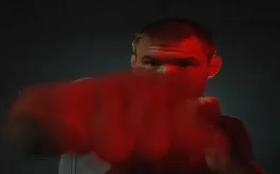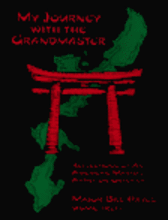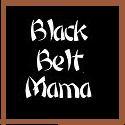Turtle Press Tang Soo Do DVDs
As any keen Tang Soo Do student will tell you, there is very little available in the way of study material available compared to the likes of arts such as Shotokan karate or Tae Kwon Do. I should know – I’m just such a student. There’s not very much available in book or DVD format that isn’t associated or affiliated with one school or another, and most long-term students will have an almost identical set of learning material they’ve picked up over the years. As you can probably imagine, I was pleasantly surprised to see that Turtle Press have a couple of DVDs aimed squarely at the Tang Soo Do student, and neither of them endorsing, representing or even showing the logo of a big school or organisation.
The two volumes are based entirely around the standard Tang Soo Do forms, or ‘hyung’, and are separated into Gup and Dan level forms. Gup grades are the beginner grades, in the same way that Kyu and Kup are in similar arts, and the first DVD takes the viewer through the most important forms for these first few years of training;
- Kicho Hyung (1-3)
- Pyung Ahn (1-5)
- Bassai
It’s great to have video references for these forms as they are very important and form the building blocks of so much of the art. Each video is very clear and obviously professionally produced, and has the advantage of being shot from multiple angles, which is great for new students who aren’t sure where their weight should be, or how the transitions between moves should look from behind or from the side for example. The Instructor, Master Song Young Kil, does a nice breakdown after the first run through a form, taking it step by step and explaining each technique as it’s performed, and where the kihap (spirit shout – think kiai karate fans) points are.
The Second DVD moves on to the Dan grade or Black Belt forms. These are the more complex hyung, and while some schools may teach slightly different ones, most will probably teach the majority of the following;
- Naihanchi Cho Dan
- Naihanchi Ee Dan
- Naihanchi Sam Dan
- Sip Soo
- Jin Do
- Kong San Goon
- Yon Bee
- Ji On
The DVD follows the same format, each form being shown multiple times and from different angles, and it’s a great reference for those advanced enough to draw some learning from them. This goes for students of non-Korean karate arts too, as the forms above are also famously Okinawan/Japanese in origin, just with different names (e.g. Naihanchi = Tekki, Kong San Goon = Kusanku, Sip Soo = Jitte). Obviously the performances and in some cases the moves may vary between some styles, but this leads me on nicely to the main problem I have with the DVDs.
The first thing that struck me when I sat down to watch these DVDs was "That’s not how we do it", and I dare say the vast majority of people who watch this will think the same thing. This is simply because different schools teach things in different ways, and the forms themselves change as the years go by, according to who is teaching and what subtle changes they might make. As early in as Kicho Hyung Ee Bu – the second most very basic form – I started noticing completely different moves. This isn’t so much a critical word against the demonstrator as a warning to new students or to those about to take up Tang Soo Do who might think that there’s only one way to perform a form, and that Master Song Young Kil is showing you it. The back of the DVD box mentions that he’s a master of Tae Kwon Do and Hapkido also, and I think it shows in some of the techniques.
On the whole these DVDs are excellent study aids, the forms are broken down nicely and the multiple views are very handy. Even the ‘pattern’ the form makes is shown on the screen. Just be aware that your school will almost certainly teach some of them differently, and that some of the more subtle touches such as proper stance, ideal weight distribution and the transitions between moves are only briefly touched upon. Given the fact that they’re so well produced, and taking into account the negative points raised above, I’m going to award the Turtle Press Tang Soo Do DVDs a BBM Review rating of….

Tang Soo Do Forms Vol. 1 – Gup Grades
Tang Soo Do Forms Vol. 2 – Dan Grades
As per BBM’s review below, there’s still a chance to win some Turtle Press Goodies. Just leave a comment on this review, no matter how big or small for your chance to win. What are you waiting for? Get replying!
Ultimate Flexibility: A Complete Guide to Stretching for Martial Arts
I used to train with this great guy. He was a couple ranks ahead of me and he was always so focused on improving himself and his technique inside and outside of the dojo. Knowing that he needed to work on flexibility, he spent an entire summer working on it by stretching with a ladder. I remember him telling me that by the end of the summer, he had achieved only one rung in flexibility and he was disappointed with that. I thought it was a fabulous accomplishment. There’s a fairly big gap between rungs! I need to shoot him an email or something and recommend Ultimate Flexibility: A Complete Guide to Stretching for Martial Arts by Sang H. Kim Ph.D.
If you’ve ever wanted to learn more about flexibility and proper stretching for training in the martial arts, this is your book. Divided into seven easy to maneuver sections, this book has it all. It starts with the "big picture" and explains stretching so that my two-year old could understand it. Next, it’s on to flexibility where issues such as age, gender, activity level and overall conditioning are addressed. Chapter three is all about stretching. There’s also lots of information in this section on stretching properly so as not to injure or weaken joints (I should have had this book months ago). Other chapter titles include: Understanding Your Body, Your Workout Plan, The Exercises, and The Workouts.
Whether you participate at a traditional dojo that teaches striking techniques and kobudo or a training school focused entirely on grappling, this book provides pictures and detailed instructions that map out a perfect warm-up, workout plan, and cool down program that will help improve your flexibility and maintain a healthy (hopefully) injury free body.
Exercises are broken down into body parts that include: the neck, arms, wrist and hand, hip, back, and even foot and ankle exercises. It’s easy to follow too, so that you can see a photograph of how it’s done and just get to it. There’s no Twister-style wondering if you’re doing something right or not.
The Workouts section includes customized workouts for light and full contact, grappling, MMA, boxing, weapons, and high kick flexibility. There are also tips in this section on how to obtain a full split (could have used that during cheerleading try-outs in junior high school) and 20 tips on high kicks.
The great things about this book are that the main points are reiterated plenty. Rereading a section is entirely unnecessary as each section ends with a review of sorts that provides Q & A of the main points for each section. With easy to understand descriptions and such great insight into flexibility and how to safely go about getting it, this book is an absolute must for any serious martial artist.
The only very small drawback to this book is that there are some typo/grammatical issues here and there throughout the book. It’s nothing that prevents one from understanding the content, but it’s just distracting enough for a former English teacher that I had to mention it.
For the overall great content and helpful nature of the book, BBM gives Ultimate Flexibility:
![]()
If you’d like to obtain your own copy of "Ultimate Flexibility" simply leave a comment below. Three copies of the book and three Ultimate Flexibility DVD’s are being given away through The BBM Review thanks to the very generous Turtle Press. You don’t even have to be brilliant. Just type in your contact info below and say "Enter Me." Drawings will be held at the end of Admired Martial Artists Month. Don’t miss your chance to win! Enter now!
Headgear Showdown
I’m not sure why, but most dojo have come to use a standard set of sparring equipment. You probably know the kind I’m talking about – dipped foam in various colors. I believe it must have been a cost-to-protection ratio that caused this style to become a mainstay in most martial arts. Dipped foam gear is form fitting, cost effective, and offers decent protection to those areas that need protecting (most often head, hands, feet, shins, and sometimes chest). I’ve conducted a little experiment with different kinds of headgear and would like to share my results with you.
First of all, here is quick look at dipped foam headgear – 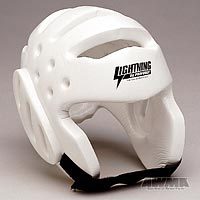
http://www.awma.com
This probably looks familiar. But here is a different kind of headgear I have been trying – 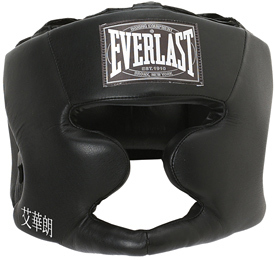
http://www.dickssportinggoods.com
It resembles boxing headgear and is actually intended for mixed martial arts practice. MMA is pretty far from my normal traditional style, but one thing about the old masters of karate is that they were concerned about what works best, and often met with each other to discuss techniques and teaching methods. In that vein, I try to keep an open mind to everything I see. When the time came to reinvest in some new sparring equipment, I noticed this kind of headgear and took a shot.
I have to say the quality of the MMA headgear seems to be much higher. The helmet encompasses my head in a comfortable fabric and seems to form-fit very effectively. The design of the faceplate covers some areas that are often exposed with foam dipped helmets. Of course, some of the foam dipped helmets have face shields that protrude out like this – 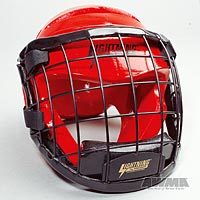
http://www.awma.com
I’ve found that these faceplates make for a target a bit closer to the opponent than your face would be, and therefore, get hit more often. The MMA headgear doesn’t really suffer from that, and still protects the face without hindering vision.
The most important factor I’ve noticed is that the MMA helmet takes hits better. Strikes are less jarring and the helmet has less tendency to shift.
Overall, I think this boxing-inspired MMA helmet is a nice piece of equipment and I would recommend it to anyone who isn’t satisfied with their foam dipped equipment.
Ikigai108 gives the MMA Helmet…
Matt Hughes Ultimate Fitness System
Those of you who follow the MMA showcase that is the UFC will be well aware of the name Matt Hughes. For those not in the know, he’s a 9-time Welterweight World Champion in the aforementioned organisation. He didn’t get there through luck, and it’s obvious to anyone who’s seen him that he’s a strong, fit and very motivated individual. It’s for these very reasons that I was very pleased to be given the opportunity to review his new Plyomix Ultimate Fitness System.
The Ultimate Fitness System is available as a five-part video download from iAmplify.com, with each video focusing on a different aspect of the training. These break down as being Core, Impact, Intensity, Power and an extra fifth video, Mental Edge which features an interview with Matt and an insight into his own training, background and mental preparation. As the names of the sections suggest, each video puts specific focus on an workout area, which is really useful as it means you can create your own routine and schedule and work it in around whatever other training you might already do. For me, this happens to be my own Martial Arts training, and training in a kick/punch system I was pleased to see some good speed and endurance drills based around sparring movements.
Each training video lasts for around an hour, and is well produced and presented. There are three people demonstrating at any one time, with input from Matt waiting in the wings as and when required. Each member of the team does essentially the same exercises, but at a varying level of intensity or difficulty. It’s a really nice touch and means that you don’t have to attempt to keep up with someone seemingly super-human, and at the opposite end of the scale there’s no need to limit your workout by matching what someone of a lower level of strength or fitness is doing. They also act as good goals for anyone wanting to push themselves, as you can start off following the lowest intensity, and as you get fitter and stronger move up to the next level.
It’s advertised as a complete fitness system, and for once it’s actually true. Everything you’d expect to be there is present such as cardio work, strength and endurance work, fast-twitch muscle building and flexibility, but it’s good to see the other important facets of a good training session, namely warm-ups and stretching. Both are sometimes breezed over with little attention in other video instructionals, but these videos provide a good realistic amount of both. Anyone who’s ever had a muscle pull or tear can probably vouch for the importance of stretching and getting warm. Whenever ‘props’ are required – such as a jump rope or hand weights – it’s clearly stated on the screen, and a nice touch is the inclusion of alternatives should they not be available (no hand weights? how about cans of soup?).
Despite all the good things I’ve already said, there’s still one thing which separates the Matt Hughes Ultimate Fitness System from its competition, and that’s the format in which it’s presented. Instead of DVDs, the videos are downloaded directly from the iAmplify site. Each is around 100MB in size, and they’re in MPEG-4 (.mp4) format. What that means to you and me is that they can easily be downloaded to a personal media player (iPod Video for example) and taken with you. Do you ever find that at home it’s really tricky to find the time to claim the living room for yourself for an hour to work out? Or maybe you have kids and find it literally impossible to clear enough toys from the room to get the space for it? Pop the videos onto your media player (or laptop) and head out somewhere else. It might only be as far as the garden, or maybe a gym or local hall, but you can take your workout with you.
I consider myself moderately fit for my age and weight, training 3 or 4 times a week in martial arts will do that for you, and I have to say that having tried these out I can vouch for just how much of a workout you get. They certainly aren’t "walk in the park" easy, and could take someone with a low level of fitness a few weeks to build up to get through the full hour without stopping, but if you’re already reasonably active or have good perseverance this can really add to your fitness and strength. It’s professionally presented, well organised and enjoyable.
You can purchase and download the Matt Hughes Ultimate Fitness System directly from the site, and by way of a special offer we’ve teamed up with iAmplify to get a special discount for BBM Review readers! Simply click the following link.
$20 OFF – when you purchase the Plyomix Ultimate Fitness System
by 9-time UFC Welterweight Champion, Matt Hughes. Use coupon code: Fight20 during checkout to save.
Learn More about PlyoMix Ultimate Fitness System by Matt Hughes
As far as workout video systems go, this has to rank among the best. The very unfit may struggle at first, but as a supplement to existing training or incorporating all of the parts as a standalone routine it’s very good at what it does. Just be prepared to work hard! TSDAdam awards the Matt Hughes Ultimate Fitness System…

Ikigai108’s Review
While watching the UFC, have you ever had that brief moment where you contemplate how you would stack up against a fighter like Matt Hughes? I think it’s pretty common. Next time that little voice pops into your head, remind yourself of this – Matt Hughes is one of the most physically fit athletes in the world and is, essentially, a destroyer of men.
I realized that pretty quickly while watching the Plyomix Ultimate Fitness System, presented by iAmplify. This system is designed to be a full body workout, ideal for anyone wanting to get in shape (but especially for those training in the martial arts). This series is presented as downloadable videos from iAmplify and comes in five main categories: power, core, intensity, impact, and mental edge. I’d like to break down my impression of each section, then give an overall review of the system.
POWER
The Power video is very similar to some existing workout tapes you might have seen. It involves a stepbox, jumprope, and a few other trademark devices of the workout industry. The Matt Hughes team takes you through a good warmup routine and then runs through a series of cardio intensive drills. However, unlike normal step programs, activities like pushups are thrown in from time to time to work on strength as well as endurance. Matt Hughes acts as the coach, helping keep each team member motivated.
CORE
The Core video is pretty darn wicked. This focuses on core strength around the abdomen/pelvic area (or hara, as the japanese martial arts like to call it). There are a wide variety of crunches and leg lifting exercises that make you feel the burn very quickly. One exercise called alternate straight leg pedaling kills me. The Hughes team faired much better than I did. If you need an ab work – this is the place to be.
INTENSITY
Intensity has a definite fighter’s slant. This workout uses resistance training and heavy bag striking (on the ground). I personally enjoyed this one due to it’s easy translation into fighting but also because the workouts were not dull in any way. One sign of a good system is keeping participants interested, and I think Intensity is a success in that realm.
IMPACT
Impact is where weight lifting and bench work comes into play. It’s not heavy weight lifting; instead, they use light-moderate weight and incorporate it into their workout. The Hughes team uses free hand weights, 5-15 pounds or so, and lead you through a series of squats and bench exercises. Impact offers a balanced combination of weight training and cardio, so people not looking to do 200 pound bench presses can still enjoy and participate.
MENTAL EDGE
This is a nice addition in the form of an interview with Matt Hughes. Anyone purchasing the videos will enjoy it, but MMA fans will especially appreciate it. The interview takes place in front of a pond on the farm where Matt grew up. He talks about his childhood and how his rural lifestyle instilled in him an excellent work ethic that has really helped bring success in professional fighting. He also talks about how he implements his workout program and some other useful pointers for preparing for a fight.
OVERALL
The exercises presented on this video are very good. This is a workout program designed to fit beginner, intermediate, and advanced users. That being said, there are a few things I’d like to comment on. First and foremost, the Matt Hughes team does 95% of the working out, with only small demonstrations by Matt himself. I would have enjoyed seeing Matt demonstrate what a real UFC fighter looks like going through the workout. I think most martial artists would agree that watching an expert can be as helpful as listening to their advice. Matt’s tips as the "coach" were indeed helpful, but not critical. There could have been someone else acting as motivator, or perhaps Matt doing a voice-over with advice as everyone worked out. I felt the biggest thing lacking in Matt Hughes’ system was Matt Hughes.
One other little pet peeve – The main aerobic instructor, Jennifer, made some excessive SSHH-ing noises. SHH, SHH, SHH. I found it a bit distracting. Also, this is not a good breathing habit to get into for martial artists because it indicates breathing from high in the lungs instead of low out of the diaphragm. I know it can’t all be diaphragm breathing when working out, but excessive SHH breathing should be avoided.
On the positive side, excellent tips and suggestions were flashed on the screen throughout the videos. Each video lets you know what to expect and what you will need in a clear and organized fashion.
I enjoyed the Plyomix Ultimate Fitness System by Matt Hughes. I think it has some really useful qualities. However, it wasn’t a homerun for me. Therefore, the result for Ikigai108 is…
$20 OFF – when you purchase the Plyomix Ultimate Fitness System
by 9-time UFC Welterweight Champion, Matt Hughes. Use coupon code: Fight20 during checkout to save.
Learn More about PlyoMix Ultimate Fitness System by Matt Hughes
My Journey with the Grandmaster
!Have you ever wondered what it would be like to train in Okinawa under one of the Grandmasters? Do you desire to understand the martial arts more deeply? Are you looking for a martial arts book that takes you on a fantastic journey? Look no further.
"My Journey with the Grandmaster" by Kyoshi Major William Hayes USMC (Ret.) is one of the most amazing books I have ever had the pleasure to read. Although there is not a single color photograph in the entire book, Kyoshi Hayes paints such a visually stunning picture of his journey in the martial arts, and of what life was like as a young Marine stationed in Okinawa learning under Shimabukuro Eizo, a Grandmaster of Okinawan Shorin-ryu Karate-do, that a reader can truly escape to Okinawa while indulging in this engrossing book.
"As I recall, the beach was almost overwhelming in its natural beauty. The sand was course but clean, the water, crystal clear close to the shoreline-deepening to a pure green and then deep blue as you looked out to sea. Over my shoulders I looked up to see some of the huge chunks of coral which had been pushed up from the ocean floor to help form the coastline. Thatches of lush greenery sprung from the seemingly hostile rocks and small sandcrabs scrambled about like tiny commuters on their way to and from work."
Vivid descriptions of the landscape, the people, the cuisine, the politics, the racial unrest during the Vietnam war in the military and of his intense training in Shorin-ryu provide the reader with a wealth of information to soak in and digest.
With the writing and the unique perspective he provides in this book, Kyoshi Hayes is able to transport you to Okinawa. Whether your style is Shorin-Ryu or something else entirely, there is something to be learned from this book. Through his retelling of some of his training stories, one can glean so much information that it makes you think about your martial arts training in a way you never have before.
"At that point in your training you are no longer in a position where a "block" is necessary. You also start to understand that the "blocking" motions can now have totally different purposes. Some of the motions may become strikes to selected points on the body or can be used to manipulate the joints-painfully-especially when the timing of the movements is changed along with the angle. These techniques when combined with the real purpose of stances expand your arsenal and the scope of the art itself."
Although it’s a book that can be easily read cover to cover in a matter of days, I found myself slowly reading it chapter by chapter to fully think about the knowledge Kyoshi Hayes was imparting through his writing. I also wanted to make it last longer since it is such an enjoyable and insightful book to read.
His insight regarding traditional karate is authoritative, and with good reason. The evolution of Kyoshi Hayes as a martial artist is apparent in every aspect of this book.
"Okinawan karate was never developed for the purpose of winning tournaments, it was formulated as a means of killing those who deserve to die and as a means of protecting the lives of those who deserve to live. Pretty basic stuff. To be sure, many of the world’s well-known karate tournament champions are students of Okinawan Karate styles but the systems put together on a tiny island of Okinawa were developed so that the practitioner would survive in real combat situations first and foremost. There were no trophies or rules in the early days of real encounters on Okinawa and such encounters required the ultimate in both efficiency and effectiveness."
Kyoshi Hayes is about to have the 6th edition of his book printed and it will be available to purchase directly through the author. For more information about the book or to purchase it directly, send an email to oldstudent1 at cox dot net. The book is available for purchase for $23 (Virginia residents add 4.5% sales tax). You can even request that the author signs the book for you, making it a treasured purchase for years to come.
My only critique of the book is that it wasn’t longer. This is the first book in a long time that I just didn’t want to end. If you’re a martial artist and you haven’t yet read this book, there’s really only one question to ask yourself: Why not?
"My Journey with the Grandmaster" is the "Grandmaster" of martial arts books, and you don’t want to miss it! For the way the book manages to transport you to the beaches and dojo of Okinawa, for the knowledge it imparts unto its readers, and for the way that it completely makes you rethink about every part of your training, BBM gives "My Journey with the Grandmaster" an unprecedented (and highest honor in the martial arts and on this site) red belt:
All excerpts from the book are printed with the authors permission.


